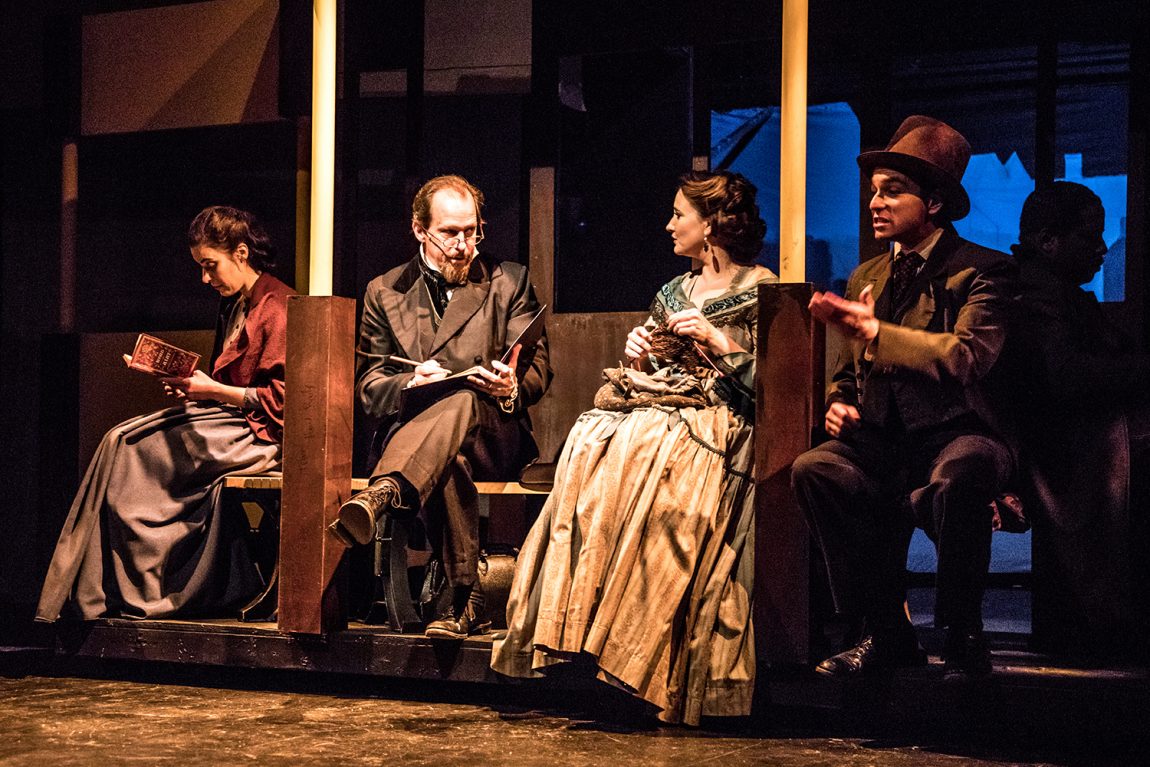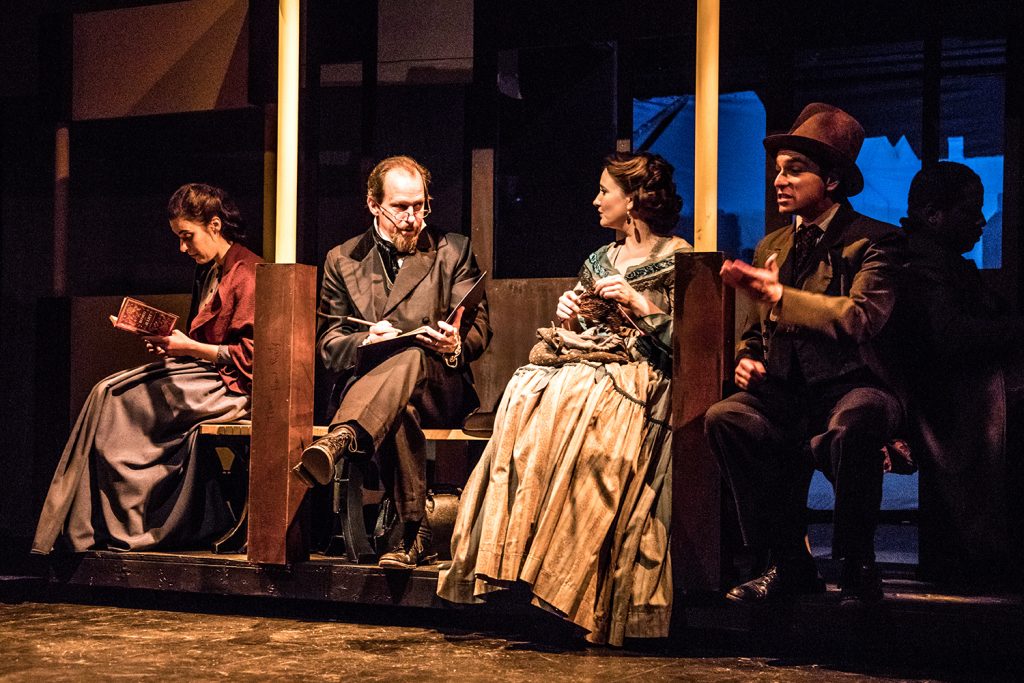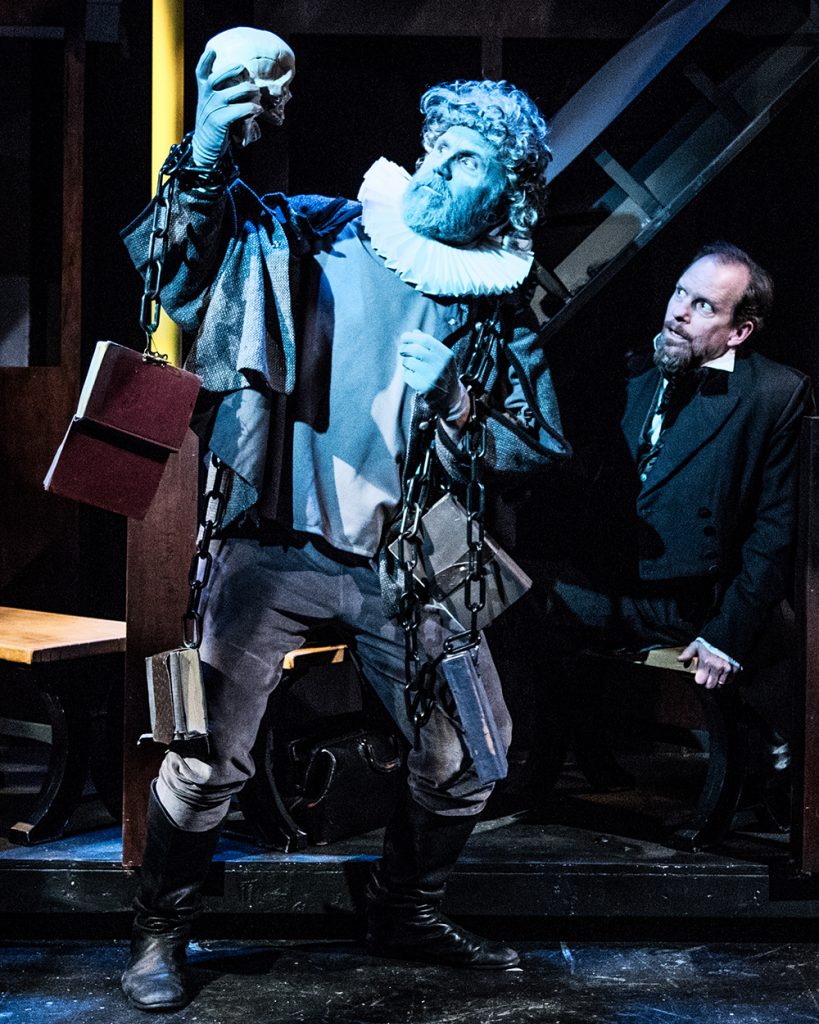
“Revising” Dickens: The Author as Scrooge in Oak Park Festival’s A Dickens Carol
Contributed by Lydia Craig, Loyola University Chicago

Used by permission.
A recent adaptation of Charles Dickens’s 1843 novella A Christmas Carol, entitled A Dickens Carol and directed by Kevin Theis, just experienced its second run at Oak Park Festival Theatre in Chicago, IL in December 2018. Playwright Ned Crowley, who quadruples as a screenwriter, director, and advertising executive, has not only adapted the well-known plot for the stage, utilizing verbatim quotes at times, but also scavenged the spectrum of Dickens’s colorful life for material. Instead of Ebenezer Scrooge, we have grumpy Charles Dickens himself in a railway car, abusing his publishers and collaborators, refusing to donate funds to the poor, and obstinate in his latest infidelity to pregnant wife Catherine (“Kate”) Hogarth. As it turns out, this is the day of the Staplehurst Rail Crash, and Dickens’s resulting concussion helps him achieve self-realization and repentance after a timely intervention by his literary idol William Shakespeare (instead of Jacob Marley) and three other London ghosts. Furthermore, it leads to the writing of A Christmas Carol, the entire proceeds of which will be donated to the London poor – courtesy of the charitable, crack publishing duo, Chapman & Hall. A mixture of humor and tragedy, as in the original tale, the path to Dickens’s regret, apology to his wife, and newfound charity inspires delight and achieves a satisfactory moral resolution.
Of course, the only problem with this autobiographical intervention is that this is not at all the accurate story of Dickens’s life, or even of the publication of A Christmas Carol, to say nothing of the Inimitable’s truly complex home life and marital fracas. To be sure, the subtitle of Crowley’s play as written in the playscript and program is admittedly “a mostly true Christmas story” (1). Similarly, both feature the following prefatory “NOTE”:
The many stories and specifics of Dickens life detailed here are all true. His marriage troubles. His book troubles. His dalliances with other women. His history in the blacking factory and apprenticeship in the law firm are also true as is the time his family spent in Marshalsea Debtors Prison. The only narrative change is the timing of the South Eastern Railway crash. A crash that nearly killed Dickens, or Bozes as some called him in his youth. That crash has been reimagined to a time just before the creation of A Christmas Carol. Reimagined as the very jolt than caused the inspiration for his holiday classic and changed the course of Dickens’ fortunes forever. (2)
Despite the explanatory note, one of the play’s current (2018) featured audience reviews by “Andrew” exclaims, “What a great evening! This is the backstory about how Charles Dickens came up with the idea for A Christmas Carol…The story is based on true events. Great for the whole family” (Oak Park). It seems that, at least for some audience members, this complex take on the usual Scrooge story has been received as the true story of Charles Dickens. However, Crowley seems unbothered by the possibility, instead prioritizing the fun of engaging with Dickens’s life in this unique way. He explains,
For those not familiar with Dickens’ life, they can enjoy the ride and ‘assume’ that many of the things might be true. I also thought it important to call those truths out in the program…I call myself on the only lapse in facts. The train crash had a powerful impact on his life, it just happened later. But when I read that tidbit about him it all came together. It was just too perfect. To see his life flashing before his eyes in the form of past present and future. It was here for the taking.” (Email)
By his own account, Crowley has chosen to fictionalize Dickens’s life for dramatic effect, as the author himself did in several of his own novels, but remains conscious of the historical need to admit this fact. Still, there are several other moments of inaccuracy in Crowley’s adaptation that go undeclared in the program, major differences between the true events and the original Scrooge plot as portrayed in A Dickens Carol. First of all, the famous novella was published twenty-two years before the horrific Staplehurst Rail Crash (1865) that killed forty passengers and injured ten – a tragedy occurring five years to the day before the shaken author’s untimely demise. In actuality, his mistress Ellen Ternan and her mother accompanied him on the train, not Kate (Tomalin, The Invisible, 145). Georgina Hogarth, depicted by Crowley as making fun of Dickens’s taciturn and grumpy nature and sympathizing with Kate, actually devoted her life to the writer and even took his side during the separation with her sister (Slater 452). Then there is the matter of the publication of A Christmas Carol, which is presented inaccurately. In the play Dickens rejects Chapman and Hall’s original request to write and “donate” a Christmas story to them for the British public, in order to spread good seasonal cheer, and then seeks them out to atone for his churlishness. In actuality, due to disappointing profits from the nevertheless popular Christmas story concerning greed and redemption, along with other creative differences, Dickens instantly determined to extricate himself from further contracts and decisively “settle up his accounts” with his long-time publisher (Patten 152). While Chapman and Hall would not publish another serial by Dickens for twenty years, his creative partnership with Bradbury and Evans, beginning with his next novel Martin Chuzzlewit (1844), brought Dickens significantly more income due to their generous, and business-savvy, terms (155). Furthermore, Dickens’s vitriolic 1858 marital separation never amicably resolved; in fact, it is well recorded that husband and wife, the parents of ten living children, never met again and only corresponded three times after their separation (Nayder 295). To show Dickens reforming and returning to a life of domestic harmony and social activism denies the true, perhaps more powerful story.
However, Crowley’s substitution of Dickens for Scrooge is well in keeping with the less generous, fun-loving sides of the author’s charismatic and impatient personality. Claire Tomalin remarks in her biography of the author that Dickens’s behavior in financially cutting off his troublesome brother Fred in 1856 has more than “a touch of unreformed Scrooge” (Charles 275). Kate Dickens Perugini, Dickens’s favorite daughter, was extremely candid in her later assessments of her father’s selfish behavior and neglect, which propelled her into a loveless first marriage with Wilkie Collins’s younger brother Charles Alston Collins, as Dickens himself apparently realized to his shame (Slater 484). But why make the substitution and comparison between author (Dickens) and literary creation (Scrooge) in the first place? In a thematic sense, what does this adaptation’s premise do for a twenty-first century audience, besides the novelty, that a more faithful literary adaptation could not achieve? Reflecting on the character he also enacts in A Dickens Carol, Theis believes switching Dickens for Scrooge onstage works because of the very autobiographical writing already written into A Christmas Carol. In a brief in-person meeting with me, he explained he sees this stage adaptation written by Crowley, a noted screenwriter, as borrowing from filmic conventions regarding biographical editing, which are justified unless actual “harm” is being done to a character’s legacy. He explains, “The story of Dickens’s life, marriage, relationship with publishers, editor, easily transferred over to the stage and to the Scrooge story” (Interview). Along the same lines, when I asked Crowley via email, “What particular challenges do you think a playwright faces when adapting, even fictionalizing or amending, an author’s biography into his or her fictional work?” the playwright admitted to being mindful of the different reactions audience members might have to the heavily fictionalized life of Dickens. He says, “I think it was important to put as much of his real life into the plot as possible… for those who really know their Dickens there is lots to be ‘in the know’ on. From his nickname to the places he worked to his hatred of the press etc.” (Email).
Certainly, substituting Dickens for Scrooge results in some excellently witty emendations to the original text, as can be seen in the following excerpts. The conductor of the Staplehurst train speaks the prologue:
But for Charles Dickens, good fortune, like the train itself, had taken a sorry turn. After four children and seven years, his marriage had soured and so had the press. And were it not impolite to speak ill of the dead, one might say that Dicken had become quite monstrous in disposition. Loathing the very subjects he wrote about, and turning a cold heart to the poor and those who had previously inspired him. His wife. His children. His adoring fans and readers. Yes Dickens was dead. Dead as a soon to be coined doornail. T’was A Merry Christmas Eve indeed. (Crowley 5)
In this reimagining, Dickens’s power and the prestige resulting from literary fame have both swelled his head and distanced him from the social issues he once championed. Though in his novels Dickens continued to depict the treatment of society’s unwanted individuals, such as orphans, unwanted children, the aged, felons, and “fallen women,” his success and position at the head of the extended (and rapidly increasing) Dickens family enabled him to adopt an authoritarian role that often shows him in an unattractive light, as biographers consistently note.
As another example of the close approximation between Dickens and the unloved schoolchild Scrooge, the Ghost of Christmas Past takes Dickens to see his debt-ridden father, John Dickens, who exploits him for labor. Crowley’s adaptation captures the fury the adult Dickens directed towards parents who failed to care, materially and emotionally, for their own children:
PAST: Shipped you off to the blacking factory. To pay off his debts.
DICKENS:What kind of parent would do such a thing?
PAST: And yet you desired to be with him. Why?
DICKENS: He was my father. I suppose every boy wants to be with his father no matter how notorious. (22)
Obviously, Dickens’s depiction of David Copperfield’s experience of child labor in his 1850 novel is closer to what is known of the author’s own history of labor in Warren’s Blacking Factory (Foster 58). Still, what comes across most clearly in A Christmas Carol is young Ebenezer’s similar balked longing for paternal approval and love, a void even his sister’s devoted love cannot fill. It is notable that Dickens used the name of his own beloved sister and playmate during those difficult childhood years – Fanny Dickens – for the character of Scrooge’s sister. Considering the likeness between their lonely childhoods filled with literature, want, and desire, perhaps Dickens could not help himself.
Having raised the specters of Dickens’s past, revealing the extent of his unpardonable blindness and cruelty to others, the Ghost of Christmas Present castigates the author for his egotism:
DICKENS: You use my own words against me, Spirit.
PRESENT: Yes, so in the future perhaps you might hold your tongue. What is it that allows you to decide who is of value and who is not? Your stature? Your celebrity? It may be that in the sight of Heaven, you are more worthless and less fit than millions of your so-called rabble. Or this man’s child! (Crowley 31)
As I watched the opening night performance in November 2017, I was struck by these specific lines, realizing anew how closely and intimately Dickens wrote his own emotional and social experiences into the original text. The fact that some parts of his life can be viewed similarly to Scrooge’s speaks volumes on the subject of Dickens’s lifelong thematic examination and critique of his own development.
Two different adaptations are occurring here in Crowley’s play-script, one historical, one literary, combining into a dramatic biographical adaptation of a literary work. Because Dickens’s self-realization does not exist in historical fact – he did not acknowledge his faults to his family and friends and make amends – A Dickens Carol appears extremely ironic, very sad, and baffling to a theatre-goer who knows the true story of Charles Dickens. However, does this biographical and literary adaptation accomplish something posthumously that Dickens repeatedly attempted to do in his novels, most famously in David Copperfield (1850), that is, to reach redemptive self-understanding through autobiographical exploration? According to Dickens biographer Michael Slater,
The Carol…shows a notable development in the consciously autobiographical element in Dickens’s writing…As a writer Dickens cannot yet, it seems, directly confront the blacking factory itself but he nevertheless comes closer here to the factual truth of his boyhood sufferings than ever before. (219)
In regard to his original vision for the play, Crowley reflected in a similar fashion,
Ultimately, I wanted to stay true to the message of redemption. I think we never tire of a good redemption story…And for those who know the play or the book by heart I wanted this to feel like CC in a parallel universe…I heard a story. A woman, after sitting for a while and thumbing through the program, turned to her husband and said “oh no, I thought this was A CHRISTMAS Carol!” And the person next to her said “don’t worry, it isn’t but it is.” (Email)
Despite its fictionalizing of Dickens’s life, this play surprisingly succeeds in capturing the overarching message of A Christmas Carol – the urgent necessity of reexamining one’s life, enjoying the privilege of life, and helping others in their lives. Upon reflection, I have realized that this adaptation can elicit the same response from all audience members, regardless of their Dickensian knowledge. To the audience members unfamiliar with Dickens’s life, the story still inspires, even if they leave believing in the fictional redemption of Charles Dickens, chastened family man and beneficent author. To the audience members familiar with the author’s life, the adaptation provokes reflection on the tragedy of a man who wrote profound human truths in a beautiful work of fiction but could not always practice them. A man who saw so much about himself and yet so little.

Used by permission.
Works Cited
Crowley, Ned. “A Dickens Carol: a mostly-true Christmas story.” Playscript. 2017.
—. Email communication. Received by Lydia Craig 13 March 2018.
Dickens, Charles. A Christmas Carol. Chapman and Hall, 1843.
Foster, John. Life of Dickens. Vol I. James R. Osgood & Co., 1875.
Nayder, Lillian. The Other Dickens: A Life of Catherine Hogarth. Cornell University Press, 2011.
Oak Park Festival Theatre. Email communication. Received by Lydia Craig 30 November 2018.
Patten, Robert L. Charles Dickens and His Publishers. Oxford UP, 1978.
Slater, Michael. Charles Dickens. Yale UP, 2009.
Theis, Kevin. Interview. 8 March 2018.
Tomalin, Claire. Charles Dickens: A Life. Penguin, 2011.
—. The Invisible Woman: The Story of Nelly Ternan and Charles Dickens. Knopf Doubleday Publishing, 2012.
Lydia Craig is a fourth-year PhD candidate in the Nineteenth Century Studies program at Loyola University Chicago. She serves as co-chair of the Dickens Society Communications Committee and is a founding member of the LUC Victorian Society (LUCVS). She just finished tweeting as Mr. Jaggers (@GE_Jaggers) for the Great Expectations Readalong. Her essay “The Devastating Impact of Lord Wharton’s Bible Charity in Wuthering Heights” appears in the upcoming Emily Brontë Bicentenary issue of Victorians Journal.Connect with her via email: lcraig1@luc.edu, Twitter: @lydiaecraig, or her website: www.lydiacraig.com.
